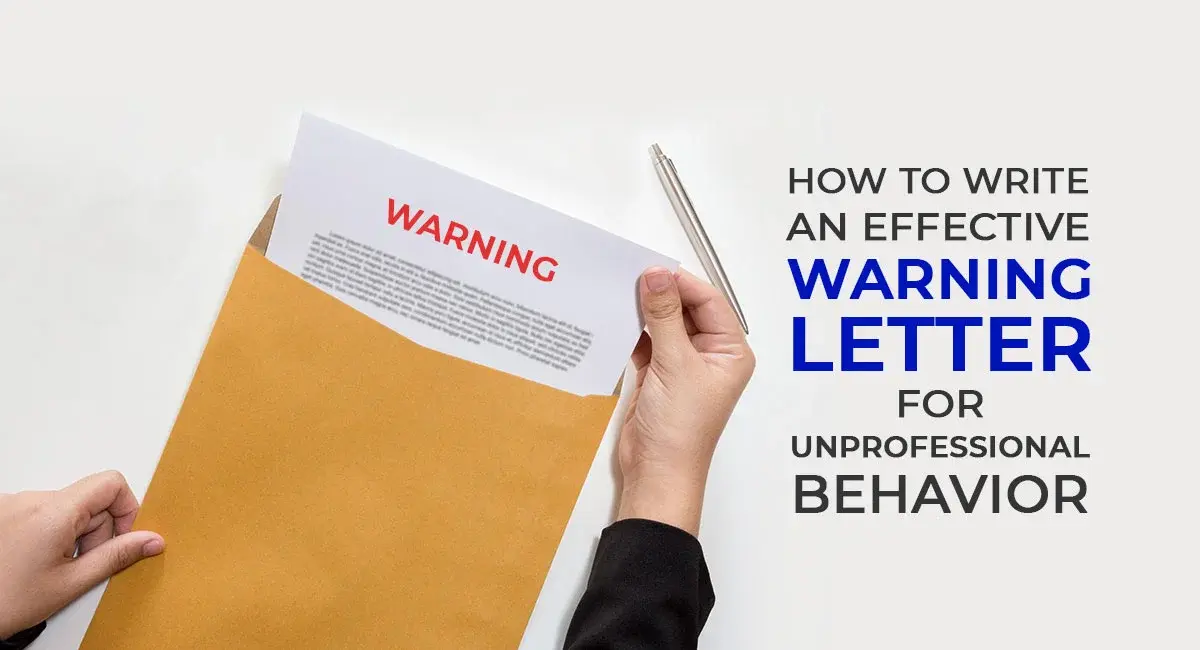Sample Warning Letter to Employee: Guide to Writing Effective Warnings In any workplace, maintaining a professional environment is crucial for ensuring productivity and fostering a respectful atmosphere among employees. However, there are times when an employee’s behavior may not align with the standards set by the company. In such situations, it becomes necessary to address the issue formally through a warning letter. A warning letter serves as an official notification to an employee about their unprofessional behavior or performance. It is an important tool for employers to communicate their concerns, set expectations, and provide a clear path for improvement. In this blog, we will discuss the full process of writing a warning letter, including a sample letter for warning, and guide you on how to address issues like unprofessional behavior effectively. Additionally, we will explore different scenarios where a sample warning letter to employees might be used, focusing on maintaining professionalism and clarity. What is a Warning Letter? A warning letter is an official written communication issued by an employer to an employee to inform them about unacceptable behavior, performance issues, or violation of company policies. The primary purpose of this letter is to notify the employee about the consequences of their actions, encourage improvement, and prevent further escalation of the issue. When an employee exhibits unprofessional behavior—such as tardiness, inappropriate language, failure to meet deadlines, or poor conduct towards colleagues—a warning letter acts as a formal reminder to correct their actions. This letter serves as part of the company’s progressive disciplinary process. Importance of a Warning Letter Issuing a warning letter is an essential part of an organization’s human resource management system. The letter is not only a way to inform the employee about their behavior but also a protective measure for the organization. Here’s why warning letters to employees are important: Clarifies Expectations A warning letter outlines what the employee did wrong and sets clear expectations for future behavior. This helps avoid confusion and provides the employee with the opportunity to improve. Documentation A written warning acts as documentation of the issue, which can be referred to if the problem persists or escalates. It provides a record of the company’s efforts to address the behavior and can be used in legal situations if the employee is eventually terminated. Prevent Escalation By addressing the issue early and formally, you can often resolve the situation before it worsens or leads to more significant conflicts or issues within the team. Encourages Improvement A sample warning letter to an employee for unprofessional behavior gives the employee a chance to correct their actions and avoid further disciplinary action. It provides them with a roadmap for improvement. Fosters Fairness By following a structured warning process, employers ensure that all employees are treated equally and fairly when dealing with behavioral issues. Common Situations That May Require a Warning Letter Warning letters are issued in various scenarios, with unprofessional behavior being one of the most common reasons. Below are a few examples where a letter of warning to employee might be required: Unprofessional Behavior This includes rude language, disrespect towards colleagues or supervisors, inappropriate communication, and other behaviors that disrupt a healthy work environment. Frequent Absenteeism or Tardiness Employees who continuously fail to show up for work on time or who have unapproved absences may receive a warning letter outlining the consequences of their actions. Failure to Meet Performance Standards If an employee is consistently underperforming and not meeting the standards set by the company, a sample warning letter to the employee can be used to address the issue. Failure to Follow Company Policies Violations of company policies, such as misuse of company resources, failure to adhere to safety standards, or inappropriate use of social media, can result in a formal warning. Dishonesty or Breach of Trust Employees found guilty of dishonesty, stealing, or breaching the trust of their employer may be given a warning letter to address the breach of conduct. How to Write an Effective Warning Letter for Unprofessional Behavior Writing a warning letter to an employee for unprofessional behavior should be done carefully and professionally, especially when using HRMS and payroll software to document the process. It is important to address the issue without being overly harsh or too lenient. Here’s a step-by-step guide on how to structure an effective warning letter: 1. Address the Letter Properly The first step in writing a sample warning letter to employee is addressing the letter correctly. It should include the employee’s name, designation, and the company’s details. Example: [Company Name] [Company Address] [City, State, ZIP Code] [Email Address] [Phone Number] Date: [Insert Date] [Employee’s Name] [Employee’s Position] [Employee’s Department] [Company Name] 2. Start with a Formal Salutation Begin the letter with a professional greeting, such as “Dear [Employee’s Name].” 3. State the Purpose of the Letter The first paragraph should clearly state the purpose of the letter. It should mention the specific behavior or performance issue that is being addressed. Be specific and provide examples of the unprofessional behavior. Example: “We are writing to formally address your unprofessional behavior in the workplace. On several occasions, including [list dates or specific instances], you have exhibited behavior that does not meet the standards expected of you. Specifically, [mention the unprofessional behavior, such as rude language, failure to meet deadlines, or inappropriate conduct].” 4. Reference Company Policy If applicable, refer to the company’s code of conduct or employee handbook, and explain how the employee’s behavior violates these policies. Example: “As per [Company Name]’s Employee Handbook, all employees are expected to maintain a professional and respectful demeanor at all times. Your actions have violated this policy, and it is essential that you correct your behavior moving forward.” 5. Explain the Consequences of Further Misconduct Make it clear that if the employee does not correct their behavior, there will be further disciplinary action. This will help the employee understand the seriousness of the matter. Example: “Please note that any further incidents of unprofessional behavior may lead to more severe disciplinary

